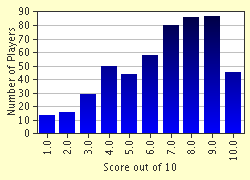Quiz Answer Key and Fun Facts
1. The Enigma code machine was initially developed to allow banks and railways to encode secret messages (although the name "Enigma" came later). Who invented this machine? (Hint: He died before World War II started.)
2. At the start of World War II, what country gave the British a head start in its effort to read messages encoded on Enigma machines? (Hint: World War II started in Europe when this country was invaded.)
3. Bletchley Park was one of the strangest military establishments in the world. The team included crossword puzzle fanatics, chess champions, mathematicians, linguists, specialists in Egyptian hieroglyphics, and even an occasional lawyer. What was the code name used to refer to the code-breaking unit at Bletchley Park? (Hint: It previously had been a radio reception post for coded German messages - think of a radio.)
4. The codebreakers at Bletchley Park gave the Allies a vital edge in the U-boat war, the tank battles against Rommel, and the D-Day invasion. What was the name given to the intelligence gained from the deciphered Enigma messages? (Hint: Winston Churchill referred to this as his _____ secret.)
5. An innovative electronic computer using 1,500 vacuum tubes (the British call them valves) and an optical paper tape reader operating at a read speed of 5,000 characters a second was developed by a British engineer to help decode Enigma messages. What was the name of this computer? (Hint: The three wrong answers are early American computers.)
6. What branch of the German armed forces added a fourth rotor to the Enigma machine, greatly increasing the number of potential combinations of encoded messages? (Hint: This branch was under the command of Karl Dönitz.)
7. An Enigma machine was captured from a German submarine just two days before the D-Day invasion (giving rise to fears the Germans might change the code just before the invasion). The captured sub is on public display at the Museum of Science and Industry in Chicago, Illinois, USA. What is the name of this sub? (Hint: This was NOT the first Enigma captured and it was NOT the title of a movie.)
8. The German high command sent their encoded messages on a machine using twelve rotors that produced an even more complicated code. What was its name? (Hint: The name is NOT the same as a manufacturer of military aircraft.)
9. What was the code name given to these high-command coded messages? (Hint: The name is NOT the same as a codename for an atomic bomb, submarine tactic, or a failed airborne invasion.)
10. After World War II was over, how many of the Colossus computers that helped decipher intercepted messages were ordered destroyed? (Hint: Winston Churchill was afraid these advanced machines would fall into the hands of the Russians during the Cold War.)
Source: Author
root17
This quiz was reviewed by FunTrivia editor
gtho4 before going online.
Any errors found in FunTrivia content are routinely corrected through our feedback system.

